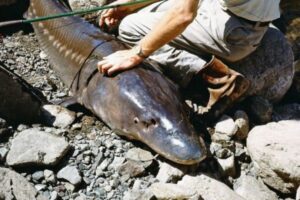200-Million-Year-Old Beluga Sturgeon Battling Extinction

Overfishing is bringing a frightening reality to Beluga sturgeon. The fish, prized for their egg sacks used in caviar, are now facing extinction. But scientists and engineers have a plan to help the mighty fish rebound.
The sturgeon is an impressive fish—larger than some sharks, growing as long as nearly ten feet. They’re old too—as in 200 million years of swimming in the Danube River and Black Sea, and one fish can live up to 100 years.
Environmentalists are working to block certain side channels of the Danube that were compromised by the Iron Gates gorge dams installed in the 1970s and 1980s, which eliminated half of the spawning areas for the fish. The goal is to divert water that would help to ensure that the fish migrate and resume reproduction.
Sturgeon farms have also appeared to help revive populations and protect them from poachers who illegally harvest their egg sacks for the most expensive caviar in the world. Sturgeon trade was banned in 2001, and Romania outlawed sturgeon fishing in 2006, as have other Eastern European countries including Serbia, Ukraine, Moldova and Bulgaria.
As Europe’s Eastern Block collapsed in 1989, the sturgeon’s populations also began to diminish—the victims of excessive poaching by Romanians, often before the fish completed their migrations to reproduce, leaving them unable to mate and resulting in a steady decline. After dams were installed across the Iron Gates gorge, many of the fish on the west side became essentially infertile, with reproduction rates halved as a result. Another threat includes recent plans by the EU to deepen shipping canals along the Danube, which could threaten shallow areas where sturgeon lay eggs. A spokesperson for the Danube-Carpathian program of the Wordwide Fund for Nature says this project could push the fish into utter extinction.
Keep in touch with Jill on Twitter @jillettinger
Photo: Homini:)

